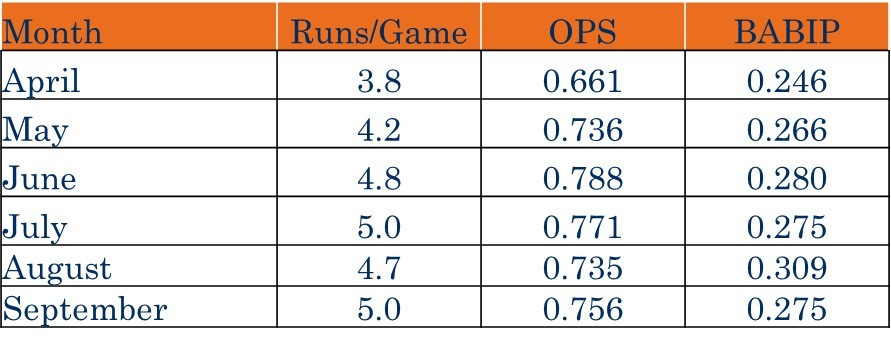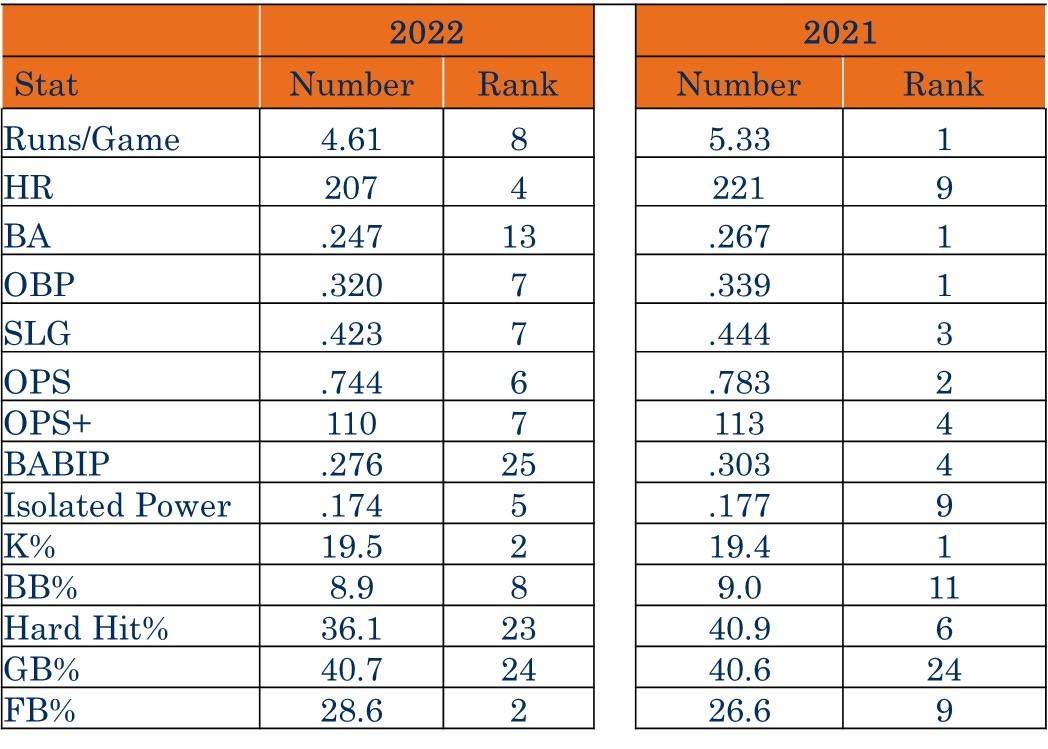Are the bats playoff worthy?
The Astros bats have taken a step back from leading the league in 2021. But they remain in the top tier in the league and have maintained their high contact approach at the plate.
When the Astros won the AL West last week, I highlighted the big improvement for Astros hurlers between 2021 and 2022 as the reason the team was able to defend its AL West title and to improve on its record in the 2021 season (they’re now 7 wins better after smashing the Diamondbacks last night…and counting).
I did not discuss the hitters. Or rather, when I talked about the hitter, I talked about how they had taken a step back in 2022 from previous seasons, writing “This year, the offense has lagged, scoring 4.6 runs per game, the fewest the Astros have scored since 2016” and that “the offense has taken a step back” from its 2021 production.
The offensive step back has been the greatest source of frustration among Astro fans this season, as the decline of the bats has been a noticeable difference with this year’s team. I will also note that fewer runs have led to more close games this season, which has increased anxiety among Astros fans in my mentions, text messages, and timeline.
And while much of those expressing frustrating with the bats will, after some prodding, acknowledge that the offensive step back was not going to keep the team from winning the division, it would matter in the playoffs.
So will it? Will the offensive step back keep the team from scoring runs in the playoffs? Today. I’ll examine the Astros offense this season and how much it has declined from the offense was saw in 2021. And I’ll address these questions with an eye to the playoffs.
Offense is Down League Wide
In 2022, the Astros have scored 4.6 runs per game, which is down from 2021, when they scored 5.3 runs per game; that is a decline of 0.7 runs per game. But when thinking about that decline, it is worthwhile to know that offense has declined across the league, from 4.5 runs per game in 2021 to 4.3 runs per game this season.
Teams around the league have scored less this season, in large due to efforts by the commissioner’s office to standardize the ball across the league. As a result, players are getting fewer hits and fewer home runs.
In fact, this is part of a larger trend across time. The figure below shows the OPS for the league in blue for the last seven full seasons. You can see that leaguewide OPS peaked in 2019 at .758. It was the time of the “happy fun ball.” The figure also includes the Astros OPS each season. You can see that the Astros have had a higher OPS than the average major league team for every season since 2017.1 And this is true again for 2022. The Astros have a team OPS this season of .740, which is 32 points higher than the league average OPS of .708.
And yet, the more important conclusion from the figure is that the Astros team OPS declined more in 2022 than the league OPS declined. The Astros lost 43 points off of their OPS while the MLB average went down 20 points.
So some of the Astros offensive decline this year is due to the general decline in offense across baseball, but not all of it. The offense has definitely taken a step back on its own.
Batting in Bad BABIP Luck
As a baseball fan, you are aware it is better to hit the ball hard, because line drives are more likely to fall in. But plenty of soft hits get through. Bloops and bleeders; duck snorts and ground balls with eyes. They all count for hits as well. But they are not evenly divided. Some players and teams get more luck on batted balls in play, as more balls find holes than the average team.
And some teams have worse luck.
The 2022 Astros are one of those teams. They have a Batting Average on Balls in Play (BABIP) of .276. That’s good for 5th lowest in baseball. Sabrmetric research has found that high and low BABIPs are mostly the product of luck.
There are some factors that influence BABIP, but for the most part, a team or a player’s BABIP will trend toward the league average over the long haul.
For example, the 2021, the Astros had a BABIP of .303, which was fourth best in the league. So one reason that the Astros were the top offense in the majors last season was that they tended to hit in good BABIP luck. That has evened out this season, as they have tended to hit in bad BABIP luck.
Will that bad luck continue? It shouldn’t. Again, over time BABIP tends to approach league average, which is .291 this season.
But then again, maybe it the bad luck will continue. The chart below shows the monthly numbers for the team for Runs per game, OPS, and BABIP. The first thing one can notice is how poorly everything went for the offense in April. The BABIP was terrible, and so was the OPS and the runs scoring. The team recovered slightly in May, with modest improvements in all three categories.
The offense really hit its stride in June and have continued to put up very good offensive numbers in the months since then. They have scored an average of 4.9 runs per game since the calendar turned to June. The BABIP has improved to something closer to league average, but only in August did the BABIP get above league average.
These data leave one conflicted. BABIP should approach league average. But the Astros have not done that over the course of the season. Will they get more hits to fall in during the playoffs because things tend to even out? Or are the Astros just a team with a low BABIP. It is hard to draw a definitive conclusion.
Still a Top Tier Offense, if Not The Best
The Astros have one of the two best pitching staffs in baseball. They have given up 3.22 runs per game, which is a sliver behind the Dodgers (3.21) for second best in the majors. The next best run prevention squad is the Yankees, who are far back at 3.55 runs per game.
But where do the bats rank among all the teams in baseball? The table below shows the Astros numbers for the 2022 season and their rank among the 30 teams in the majors. For comparison, I also included the teams’ stats and rank for the 2021 season.
The numbers tell two basic stories. First, the offense has indeed taken a step back from the 2021 season. Their numbers are down, but so it their rank. The decline is more than a function of the decline in leaguewide offense in 2022.
And second, despite the decline, the Astros bats are in the top third of the majors in most offensive categories. They are 8th in runs scored, 7th in on base percentage and slugging percentage, and 6th in on base percentage. That’s a good, but not great offense.
The chart also shows that the area where they have most improved (relative to the league) is in power. They have moved from 9th to 4th in home runs and from 9th to fourth in isolated power. Yet, their hard hit percentage has gone down both in the raw number (from 40.9% to 36.1%) and in rank (from 6th to 23rd).
They are also hitting a higher share of fly balls this year, which maintaining a relatively low rate of ground balls. Ground balls tend to be bad for hitters, as they don’t go that far, are more easily fielded, and can never be a home run. It’s better to hit a fly ball—they can be homers or balls off the fence.2
The offense is good, not great. It is in the top third of the league, but is not the juggernaut we saw in the 2021 season.
Still High Quality Plate Approaches
Last October, I wrote in previewing the World Series that “[t]he Astros offense in 2021 “center[ed] around high levels of contact. They had the lowest strikeout rate of any team in the majors.” And before the ALDS matchup against the White Sox, I wrote that “Astros hitters make contact better than any other team, putting pressure on the defense.”
As we look ahead to this October, I wanted to see if the Astros ability to make contact had help up in 2022 despite the step back in offense. The chart below shows data from Fangraphs that focus on the approach that the Astros have at the plate and compare it to the 2021 team.
First of all, the data show how top notch the 2021 Astros were with their plate approach, leading the league in five of the six categories under study here. But with that out of the way, the 2022 team looks pretty good in their measures of plate approach.
For example, their strikeout rate remains very low, having increased by 0.1% between 2021 and 2022. They have been passed for first by the Guardians, but they are in first in the majors in K/BB ratio. That is, they do the best job of combining taking walks with avoiding strikeouts. It’s an enviable combination, especially as we enter the playoffs.
The team has declined some in other categories, having increased their rate of swinging strikes (Sw Stk%) and the rate of chasing pitches outside of the strike zone (O-Swing%). Some of this is the result of replacing Carlos Correa, a disciplined hitter, with Jeremy Pena, who takes fewer pitches and swings and misses more than his predecessor at shortstop.
But overall, these numbers how that the Astros continue to have a very strong plate approach that features high contact and a good ratio of walks. If you don’t throw the Astros strikes, they will take a walk. If you throw it in the strike zone, they are likely to hit it. This produces good results for the offense.
Should We Worry About the Bats in October?
There is a consistent theme to these offensive numbers for the Astros. They have taken a step back from their league leading numbers in the 2021 season, but the step back is modest. The team remains in the top third of the majors in most offensive categories.
More importantly, the team has not changed its plate approach much from the 2021 season. The Astros offense avoids strikeouts and puts lots of balls in play. They are willing to take walks, which forces pitchers into the strike zone. They have declined a little at chasing pitches outside of the strike zone, but the overall plate approach numbers are solid.
This leads to the question that has animated this analysis: should we worry about the Astros bats this October? One answer is obviously yes. The playoffs are a series of short series and that means each series is essentially a crapshoot. The bats could go cold for a couple games, and we’re all saying “Welp.” That is true every year in the playoffs.
But these numbers tell me we should not worry more than any other October. The overall offense looks good enough that we should expect them to score runs. They have done a good job of that over the last four months of the season. Let’s hope they do it for one more month as well.
That they have won the American League West in every one of these seasons is not a coincidence.
The slugging percentage for the average major leaguer on ground balls is .259. The slugging percentage for the average major leaguer on fly balls is .630. Fly balls lead to more runs.
The Guardians K% is 17.9%, notably lower.








